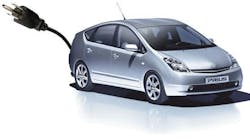The electric vehicle market in 2013 could double in the U.S. as not only consumers but also businesses and the military get on board.
Around 50,000 light-duty electric vehicles were sold in the United States in 2012, according to Pike Research, Boulder, Colo., and the market is expected to grow by 50% or more in 2013. Recent forecasts of electric vehicle sales worldwide suggest sales will hit 3.8 million units annually by 2020.
Pike predicted that between 2012 and 2020, 1.8 million electric vehicles will be sold in the 102 largest U.S. cities.
Cities like New York, Los Angeles, San Francisco and Seattle combine large population areas with early rollout schedules from vehicle manufacturers, and positive attitudes toward plug-in electric vehicles among residents, Pike found.
Defense Department Testing EVs' Use as Back Up Energy Storage
Given the way technologies and techniques developed by the military often filter out into the wider culture, a series of pilot projects by the U.S. Department of Defense exploring the use of plug-in electric vehicles as revenue generators feeding power back into the grid and as power-storage devices have the potential to make the general public look at their electric vehicles as more than a mode of transportation.
Katherine Hammack, assistant secretary of the Army for installations, energy and environment, told The Federal Times that some DoD projections show the revenue from utility companies for the returned power could completely offset the vehicles’ costs.
DoD is expanding the $20 million program started in Los Angeles Air Force Base to five other installations: Fort Hood, Texas; Joint Base Andrews, Md.; Naval Air Weapons Station China Lake, Calif.; Joint Base McGuire-Dix-Lakehurst, N.J.; and Marine Corps Base Hawaii.
The Pentagon isn’t the only organization looking at using EVs this way, of course. In the coming decade, the energy stored in plug-in electric vehicle (PEV) batteries will increasingly be made available to commercial buildings with intelligent building energy management systems (BEMS) to proactively manage energy consumption and costs.
These concepts, known as vehicle-to-building (V2B) and vehicle-to-home (V2H) technology, have the potential to provide storage capacity to benefit both vehicle and building owners by offsetting some of the higher cost of PEVs, lowering buildings’ energy costs, and providing reliable emergency backup services, said another report from Pike Research.
Pike forecasts that annual investments in upgrades to vehicles and to buildings in pursuit of V2B, which include power electronics, inverters, and power management software, will grow to more than $76 million worldwide by 2020.
Find out which state is considering assessing fees on EVs in "Electric Vehicles" in Electrical Marketing.



